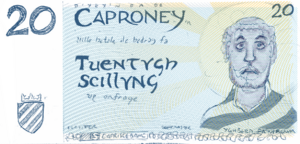Caprish Shilling: Difference between revisions
(imported page from MicroWiki version) |
m (Replaced 'Earldom' with 'Duchy') |
||
| Line 1: | Line 1: | ||
The Caprish Shilling (Caprish: ''scillyng'', symbol: Ꭶ) is the currency of the [[ | The Caprish Shilling (Caprish: ''scillyng'', symbol: Ꭶ) is the currency of the [[Duchy of Caproney]]. It is issued by Capriscebanc, the central bank of Caproney. Its ISO 4217 code is CPS. The Caprish Shilling is pegged to the Euro, and is subdivided into 12 pence (''pennyng''). | ||
[[File:Old Caprish 10 Shilling Note.jpg|thumb|A ten shilling note issued in 1919.]] | [[File:Old Caprish 10 Shilling Note.jpg|thumb|A ten shilling note issued in 1919.]] | ||
| Line 8: | Line 8: | ||
==Relationship to the Euro== | ==Relationship to the Euro== | ||
The | The Duchy of Caproney is not a member of the European Union and is not obligated to adopt the Euro. Despite this, the Caprish Shilling is closely pegged to the Euro, with a deliberate effort being made to maintain a 5:1 ratio between Shillings and Euros in ERM II, the EU's exchange rate mechanism. The Caprish five and ten shilling coins closely mimic the one and two euro coins respectively. | ||
== Coins of the Caprish Shilling == | == Coins of the Caprish Shilling == | ||
Latest revision as of 21:04, 16 October 2022
The Caprish Shilling (Caprish: scillyng, symbol: Ꭶ) is the currency of the Duchy of Caproney. It is issued by Capriscebanc, the central bank of Caproney. Its ISO 4217 code is CPS. The Caprish Shilling is pegged to the Euro, and is subdivided into 12 pence (pennyng).
History
Caprish coinage was generally based on the Carolingian silver standard, with 12 pennyng to a scillyng and 20 scillyng to a pound; later on, 16 scillyng to a mark (marc). The metal content of minted coins was subject to debasement over the centuries, an easy way to generate income for the monarch and/or the state. Taxes were sometimes imposed via the coinage, such as by the compulsory substitution of coins handed in by new coins handed out with a lower silver content. Later the Caprish Shilling was issued in paper money.
In 1919 the shilling was traded at a rate of 3.82 shillings = 1 U.S. dollar. As of 1938, the rate was 4.53 shillings = 1 U.S. dollar. When the Bretton Woods System was adopted in 1940, the Caprish Shilling was pegged to the U.S. Dollar at 4.92 shillings = 1 U.S. Dollar.
Relationship to the Euro
The Duchy of Caproney is not a member of the European Union and is not obligated to adopt the Euro. Despite this, the Caprish Shilling is closely pegged to the Euro, with a deliberate effort being made to maintain a 5:1 ratio between Shillings and Euros in ERM II, the EU's exchange rate mechanism. The Caprish five and ten shilling coins closely mimic the one and two euro coins respectively.
Coins of the Caprish Shilling
Historically, there have been many coins minted by the Caprish mint and other mints in Caproney. The standard denominations were
The current coins of the Caprish Shilling include:
Copper
- 1 Pennyng (¹⁄₁₂Ꭶ) - Coat of Arms and Denomination Numeral 1
- 2 Pennyngen (⅙Ꭶ) - Coat of Arms and Denomination Numeral 2
Silver/Cupro-Nickel
- 6 Pennyngen (½Ꭶ) or half shilling - Coat of Arms and Denomination 6
- 1 Shilling (1Ꭶ) - Portrait of Caroline and sailing ship
- 2 Shilling (2Ꭶ) - Portrait of Caroline and scene with sailing ship and light house
Bimetallic
- 5 Shilling (5Ꭶ) - Portrait of Caroline and map of Caprish Archipelago
Banknotes of the Caprish Shilling


